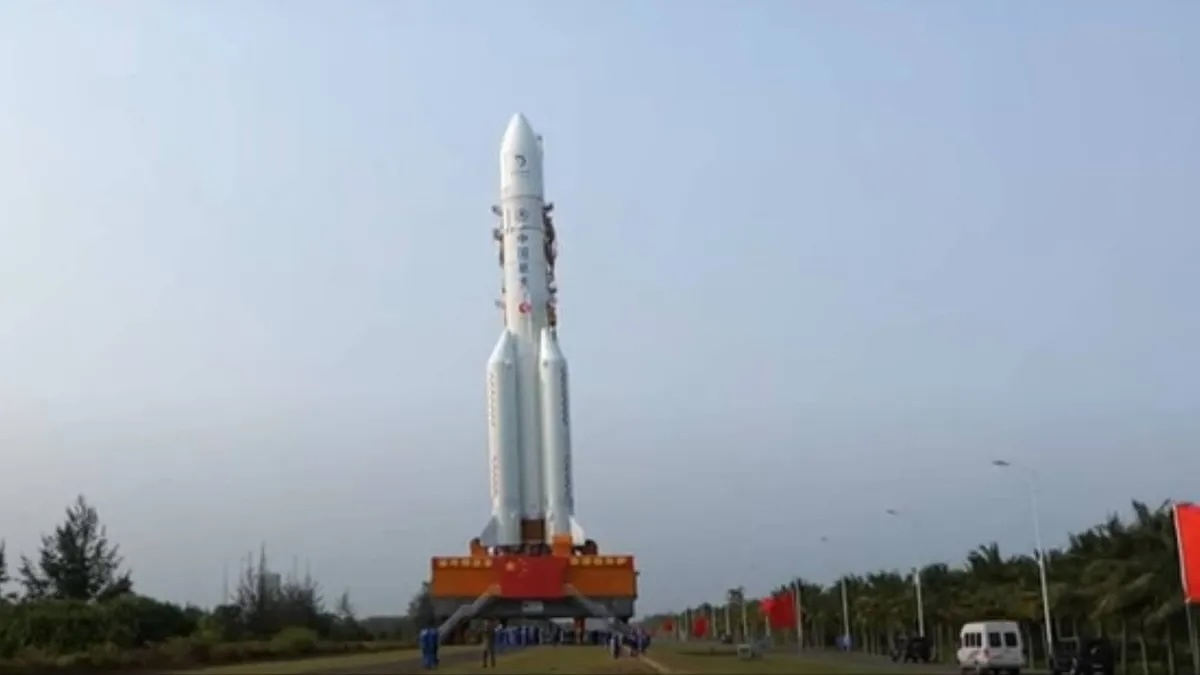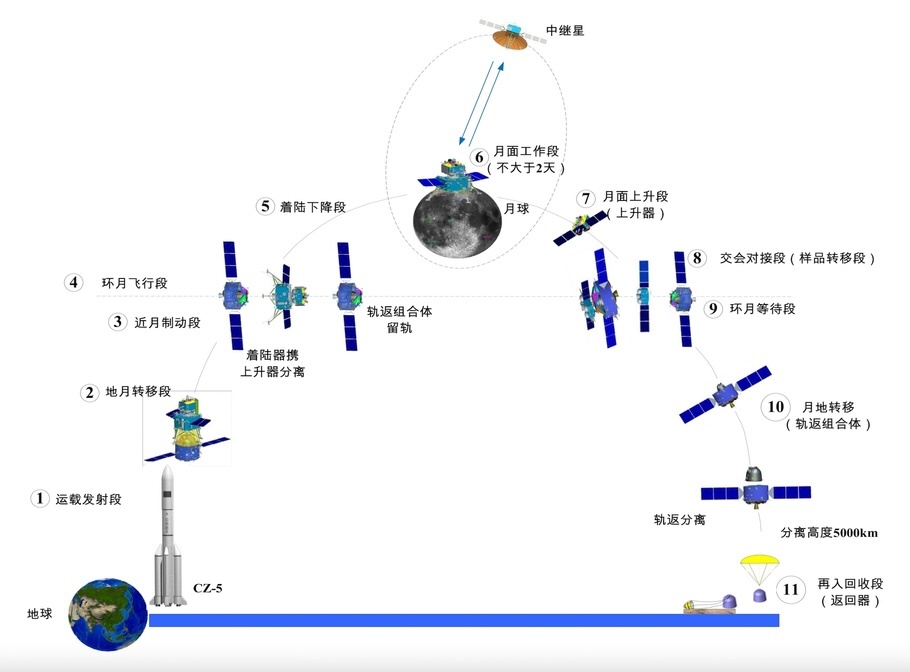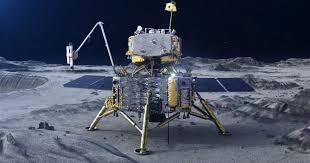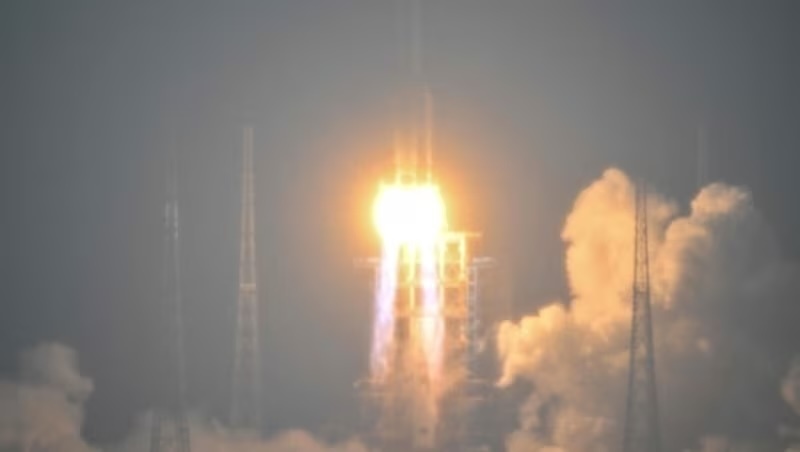2.05.2024
China to launch sample-return mission to the moon's far side on May 3
The Chang'e 6 mission is reportedly scheduled to launch early Friday morning (May 3).

China’s Chang’e 6 lunar sample-return mission atop a Long March 5 rocket at its departure site in Wenchang, Hainan province. (Image credit: CCTV)
Launch preparations are quickening for China's next spacecraft sendoff to the moon — the robotic Chang'e 6 mission.
The spacecraft now sits atop a Long March 5 rocket at its departure site in Wenchang, in China's Hainan province. Chang'e 6 is reportedly scheduled to launch on Friday (May 3) at 3:50 a.m. EDT (0759 GMT; 3:50 p.m. Beijing time).
The 8.2-metric-ton Chang'e 6 is targeted to touch down in the South Pole-Aitken (SPA) Basin on the far side of the moon. The mission consists of four components: an orbiter, a lander, an ascender and a reentry module.
First-time try
Chang'e 6 will make the first-ever attempt to return dust and rocks from the lunar far side. If all goes to plan, these samples will be placed on the ascender for transport from the surface into lunar orbit, followed by transfer into a reentry module that hauls the collectibles to Earth.
The United States, the former Soviet Union and China have all brought lunar samples to Earth. China was the most recent to do so, with its Chang'e 5 mission in 2020. But all of this material was collected on the near side, the part of the moon that's always facing Earth.
China scored the first-ever soft landing on the lunar far side with its Chang'e 4lander-rover mission back in early January 2019.
According to Xingguo Zeng, of the Laboratory of Lunar and Deep Space Exploration at the National Astronomical Observatories, Chang'e 6 is designed to address questions about the multiple lunar near side–far side dichotomies, and to provide new insights into both the early impact history of the solar systemand the geological evolution of the moon.
Toward that end, Chang'e 6 will touch down in the southern part of the Apollo basin, which provides access to a diversity of SPA material, Xingguo recently stated in a paper published in Nature.
Design and control
"The Chang’e 6 aims to achieve breakthroughs in the design and control technology of the moon's retrograde orbit, intelligent sampling, takeoff and ascent technologies, and automatic sample-return on the far side of the moon," Ge Ping, deputy director of the Center of Lunar Exploration and Space Engineering for the China National Space Administration, told told China Central Television (CCTV).
“At present, the Long March 5 carrier rocket and the Chang'e 6 probe are in good condition," Ge added. "All preparations for the launch are progressing in an orderly manner, following normal working procedures."
Liao Guorui, an engineer at the Wenchang Spacecraft Launch Site, told CCTV:
"At present, the launch site has ensured the normal testing of Chang'e 6 and the Long March-5 Y8 carrier rocket. Our Hainan launch site features high temperatures, high humidity, and high salt mist. We have made corresponding preparations for the environmental conditions, and we have also prepared some typhoon prevention plans to adapt to the weather in Hainan."
Details of the launch window were spotlighted by Zhu Haiyang, a staff member with the China Academy of Launch Vehicle Technology.
"The signature feature of the Chang-e 6 mission is that it has extra high requirements for the launch window, mainly due to the lunar orbit. In order to achieve an optimal energy, it has a high requirement for the launch time of the rocket and the time of delivery to the Lunar Transfer Orbit [LTO], so the launch window is relatively narrow," Zhu told CCTV. "We have carried out some verifications for the 'narrow window and multi-orbit' technology."

Diagram showing the various phases of the Chang'e 6 lunar sample-return mission. (Image credit: CNSA)
Transfer point
For this Chang'e 6 launch, 10 lunar orbits for the rocket have been designed. Chang'e 6 needs to enter the LTO with a perigee (closest approach point) of 125 miles (200 kilometers) and an apogee (most distant point) of 255,000 miles (410,000 km), and the requirement for orbit entry accuracy is also extremely high.
"As for the rocket, we mainly need to send it to the LTO transfer point,” Zhu added. "In terms of process coordination before launching at the launch site, coordination and drills were also carried out around the narrow window multi-orbit technology. With higher accuracy in orbit insertion, less propellant will be consumed by Chang'e-6 for its attitude adjustment, including orientation, orbit elevation, and orbit change."
Scoop and drill
According to James Head, noted lunar scientist at Brown University, the Chang'e 6 mission is very similar to Chang'e 5 in terms of its spacecraft and its operational strategy: It will acquire scoop and drill samples, totaling perhaps up to 4.4 pounds (2 kilograms).
The recently launched Queqiao 2 far side communications satellite is in lunar orbit, tested, and is fully functional to support not only the Chang'e 6 mission but also the follow-on Chang'e 7 and Chang'e 8 robotic expeditions, which will support the establishment of a moon base called the International Lunar Research Station (ILRS), Head said.
Quelle: SC
+++
China’s Chang’e 6 to carry Pakistan payload to moon
China is poised to launch a robotic spacecraft, Chang’e 6, in the coming days for a groundbreaking mission to the far side of the moon. This mission will not only mark a significant step in lunar exploration but also highlight the collaborative efforts of multiple nations in advancing scientific knowledge.
The Chang’e 6 mission will carry payloads, including satellites, from Pakistan, France, Italy and Sweden underscoring the international cooperation in lunar exploration.
Meanwhile, according to the Institute of Space Technology of Pakistan, the satellite ICUBE-Q has been designed and developed by IST in collaboration with China’s Shanghai University SJTU and Pakistan’s national space agency SUPARCO.
ICUBE-Q orbiter carries two optical cameras to image the lunar surface. Following successful qualification and testing, ICUBE-Q has now been integrated with the Chang’e6 mission. Chang’e6 is the sixth in a series of China’s lunar exploration missions.
The launch activity will be telecast live on the IST website and social media platforms. Chang’6 will touch down on the moon’s far side to collect samples from the surface and return to Earth for research. The mission holds significance for Pakistan as it will also take a Pakistan CubeSat Satellite iCube-Q, developed by IST.
CubeSats are miniature satellites typically characterised by their small size and standardised design. They are constructed in a cubic shape, consisting of modular components that adhere to specific size constraints.
These satellites often weigh no more than a few kilogrammes and are deployed in space for various purposes. The primary purpose of cubesats is to facilitate scientific research, technology development, and educational initiatives in space exploration.
Quelle: Pakistan Observer
+++
China to launch Chang'e-6 lunar probe on May 3
The Chang'e-6 lunar probe is scheduled for launch on May 3, according to the China National Space Administration (CNSA) on Wednesday.
The probe is set to collect samples from the far side of the moon, making this mission the first of its kind in human history.
At present, preparations for the mission are progressing steadily at the Wenchang Space Launch Site in south China's Hainan Province, and the Long March-5 Y8 carrier rocket will soon be refuelled with propellant, the CNSA said.
As there is a narrow launch window on the two consecutive days, with only 50 minutes for each day, the mission's rocket team has designed a total of 10 trajectories, the CNSA added.
The Wenchang Space Launch Site on Wednesday conducted a final rehearsal for the launch, covering all relevant systems comprehensively.
The site's meteorological system has strengthened its monitoring and analysis processes to ensure a successful launch.
The Chang'e-6 lunar probe and Long March-5 Y8 carrier rocket combination was transferred vertically to the launch area on Saturday.
Quelle: Xinhua
----
Update: 4.05.2024
.
China to launch Chang'e-6 lunar probe on Friday afternoon

The Chang'e-6 lunar probe is scheduled to be launched between 5 p.m. and 6 p.m. (Beijing Time) on Friday, with the preferred launch window targeted at 5:27 p.m., the China National Space Administration (CNSA) said.
The Chang'e-6 mission is tasked with collecting and then returning samples from the moon's mysterious far side to Earth -- the first endeavor of its kind in the history of human lunar exploration.
The Long March-5 Y8 rocket, which will carry the Chang'e-6 probe, has begun the process of taking on liquid oxygen cryogenic propellant at the Wenchang Space Launch Site on the coast of China's southern island province of Hainan, the CNSA added. This propellant will serve as fuel for the carrier rocket.
The Chang'e-6 spacecraft comprises of an orbiter, a lander, an ascender and a returner.
The mission will carry four payloads developed through international cooperation. Scientific instruments from France, Italy and the European Space Agency are aboard the Chang'e-6 lander, while a small satellite from Pakistan is aboard the orbiter.
About 50 guests from 12 countries and international organizations have been invited by the CNSA to attend a workshop focusing on the international payloads carried by Chang'e-6 and witness the launch in Hainan.
An impact crater known as the Apollo basin, located within the South Pole-Aitken Basin on the far side of the moon, has been chosen as the primary target landing and sampling site for the Chang'e-6 mission.
After the spacecraft reaches the moon, it will make a soft landing. Within 48 hours after landing, a robotic arm will be extended to scoop rocks and soil from the lunar surface, while a drill will be used to bore into the ground. Scientific detection work will be carried out simultaneously.
After the samples are sealed in a container, the ascender will take off from the moon and dock with the orbiter in lunar orbit. The returner will then carry the samples back to Earth, landing in Siziwang Banner in north China's Inner Mongolia Autonomous Region. The entire mission is expected to last about 53 days, the CNSA said.
Quelle: Xinhua
+++
China launches first probe to collect samples from far side of Moon

The probe is set to land in the immense South Pole-Aitken Basin, one of the largest known impact craters in the solar system.
China launched a probe on Friday to collect samples from the far side of the Moon, a world first as Beijing pushes ahead with an ambitious programme that aims to send a crewed lunar mission by 2030.
A rocket carrying the Chang'e-6 lunar probe blasted off from the Wenchang Space Launch Centre in southern China's Hainan province just before 5:30 pm (0930 GMT), AFP journalists near the site said.
Heavy rain engulfed the site just minutes before the launch began, they said, with hundreds of onlookers gathered nearby to witness the latest leap for China's decades-long space programme.
Washington has warned that the programme is being used to mask military objectives and an effort to establish dominance in space.
The Chang'e-6 aims to collect around two kilograms (4 pounds) of lunar samples from the far side of the Moon and bring them back to Earth for analysis.
State news agency Xinhua hailed it as "the first endeavour of its kind in the history of human lunar exploration".
It is a technically complex 53-day mission that will also see it attempt an unprecedented launch from the side of the Moon that always faces away from Earth.
"The whole mission is fraught with numerous challenges, with each step interconnected and nerve-wracking," Wang Qiong, deputy chief designer of the Chang'e-6 mission, told Xinhua.
The probe is set to land in the immense South Pole-Aitken Basin, one of the largest known impact craters in the solar system.
Once there, it will scoop up lunar soil and rocks, and carry out other experiments in the landing zone.
It must then lift off from the Moon's surface and retrace its steps back home.
- Space dream -
Plans for China's "space dream" have been put into overdrive under President Xi Jinping.
Beijing has ploughed huge resources into its space programme over the past decade, targeting a string of ambitious undertakings in an effort to close the gap with the two traditional space powers -- the United States and Russia.
It has notched several notable achievements, including building a space station called Tiangong, or "heavenly palace", to which it sent a fresh crew of three astronauts last month.
Beijing has landed robotic rovers on Mars and the Moon and made China only the third country to independently put humans in orbit.
China aims to send a crewed mission to the Moon by 2030 and plans to build a base on the lunar surface.
The United States is also planning to put astronauts back on the Moon by 2026 with its Artemis 3 mission.
The rapid advance of China's space programme has raised alarm bells in Washington, with the head of NASA warning last month that the United States was now in a "race" against Beijing.
"We believe that a lot of their so-called civilian space program is a military program," NASA administrator Bill Nelson told lawmakers on Capitol Hill.
- Dark side -
Chang'e-6 is the first of three high-wire uncrewed missions to the Moon planned by China this decade.
Its successor, Chang'e-7, will scour the lunar south pole for water, while Chang'e-8 will attempt to establish the technical feasibility of building a planned base, known as the International Lunar Research Station, with Beijing saying a "basic model" will be completed by 2030.
Scientists say the Moon's dark side -- so-called because it is invisible from Earth, not because it never catches the sun's rays -- holds great promise for research because its craters are less covered by ancient lava flows than the near side.
That might mean it is more possible to collect material that sheds light on how the Moon formed in the first place.
"The samples collected by Chang'e-6 will have a geological age of approximately 4 billion years," Ge Ping, vice director of China's Lunar Exploration and Space Engineering Center, told journalists.
"Collecting lunar samples from different regions and geological ages, and conducting experiments is of great value and significance for humanity."
Quelle: SD
+++
Chinas Raumschiff „Chang‘e 6“ am Weg zum Mond

China hat am Freitag das Raumschiff „Chang‘e 6“ auf den Weg zum Mond geschickt. Eine Rakete vom Typ „Langer Marsch-5 Y8“ hob am Nachmittag (Ortszeit) vom Weltraumbahnhof Wenchang auf der südchinesischen Tropeninsel Hainan ab. Die unbemannte Sonde soll auf der erdabgewandten Seite des Mondes landen und von dort Gesteinsproben zur Erde zurückbringen.
Es ist bereits die sechste Mondmission der Chinesen seit 2007. Zuletzt hatte „Chang‘e 5“ im Jahr 2020 Proben von der Vorderseite des Mondes zur Untersuchung zur Erde gebracht. Zuvor war 2019 mit „Chang‘e 4“ erstmals ein Rover auf der Mondrückseite gelandet und hatte dort das Terrain erkundet.
Mission soll insgesamt 53 Tage dauern
Für die neue Mission ist geplant, dass der Orbiter zunächst in eine Mondumlaufbahn einschwenkt. Der abgesenkte Lander steuert dann das Zielgebiet im südpolaren Aitken-Becken an, wo er Proben nehmen soll. Das gesammelte Material wird dann an das Aufstiegsmodul übergeben, das es zurück zum Orbiter bringt. Dann beginnt der Rückflug zur Erde. Insgesamt soll die Mission rund 53 Tage dauern.
Wie das Wissenschaftsmagazin „Science“ berichtet, handelt es sich bei der Landestelle um den größten und ältesten Einschlagskrater des Mondes. Das Becken hat demnach einen Durchmesser von mehr als 2500 Kilometern und ist acht Kilometer tief. Wissenschaftler wollen schon lange Gesteinsproben aus dieser Region gewinnen.
Man vermutet, dass das Becken bei einem Asteroideneinschlag entstanden ist. Aber wie lange ist das her? Einige Forscher gehen davon aus, dass das Becken vor 4,3 Milliarden Jahren entstand, andere glauben, dass der Einschlag hunderte Millionen Jahre später erfolgte, heißt es in „Science“.
Instrumente mehrerer Länder an Bord
Wie bei früheren Missionen lässt China auch bei „Chang“e-6" Instrumente aus anderen Ländern mitfliegen. So führt die Sonde Ausrüstung und Geräte aus Frankreich, Italien, Schweden und Pakistan mit. Für China wäre die sechste erfolgreiche Mondmission auch ein Prestigeerfolg. Allein schon deshalb, weil in jüngster Vergangenheit Mondsonden aus Indien, Israel, Japan und Russland nicht wie geplant ihr Ziel erreichten.
Zur Vorbereitung der Mission hat die Volksrepublik bereits einen Kommunikationssatelliten in den Mondorbit gebracht. Dieser ist notwendig, damit die Sonde Kontakt zum Kontrollzentrum auf der Erde halten kann, da sie auf der erdabgewandten Seite im Süden des Mondes landen soll.
Bemannte Mission für 2030 geplant
Bis 2030 will China eine bemannte Mission zum Mond schicken. Der Erdtrabant ist für viele Nationen auch deshalb wieder interessant geworden, weil dort wertvolle Rohstoffe vermutet werden.
Quelle: Kronen Zeitung
